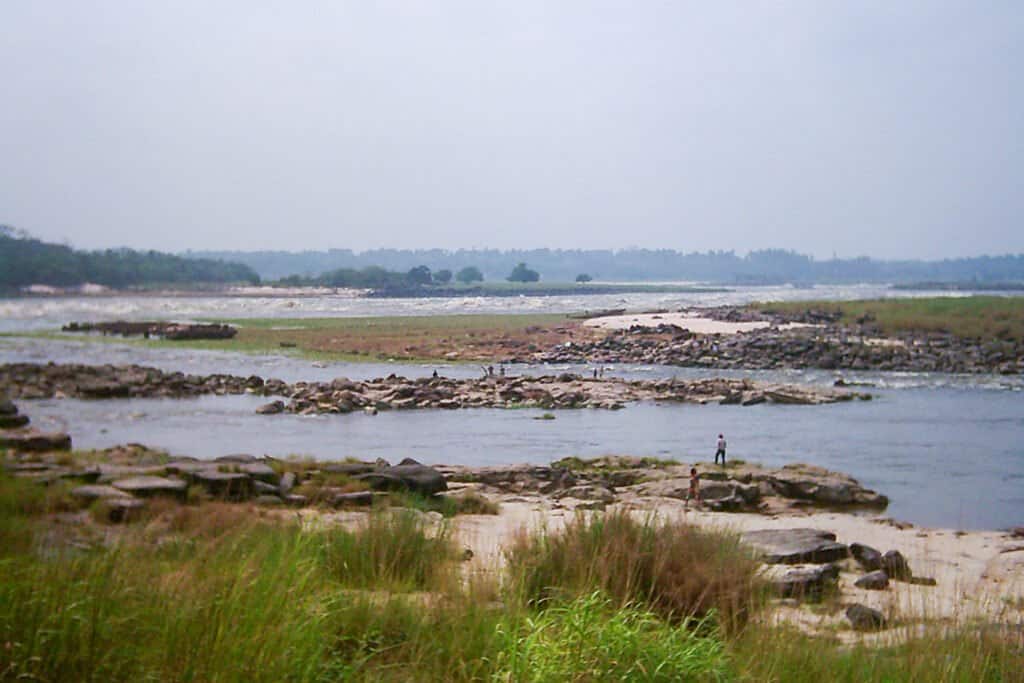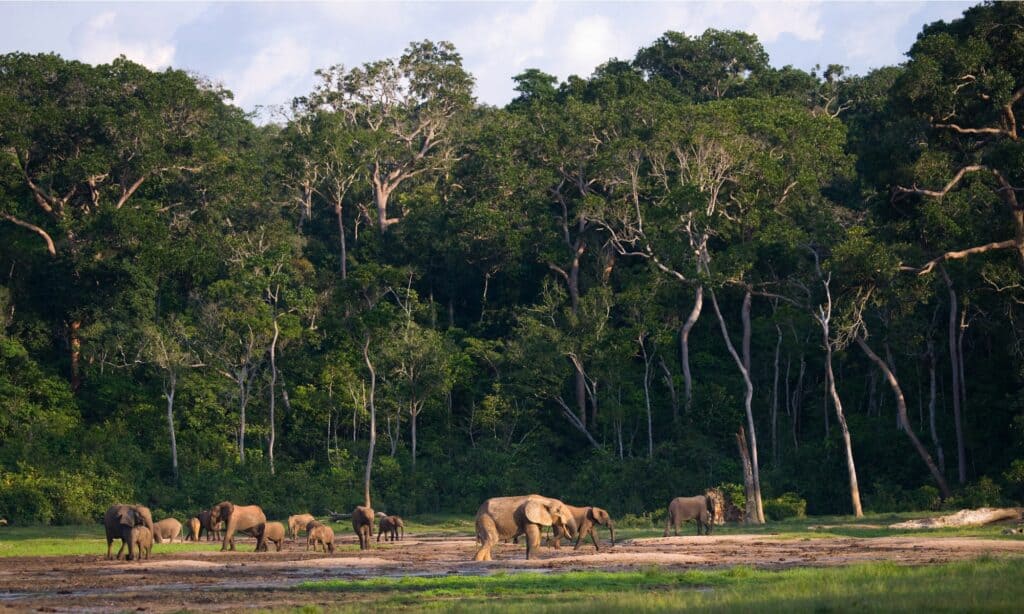Few names evoke an air of mystery and danger like the Congo. From Joseph Conrad’s famous novella Heart of Darkness to the myriad explorers throughout history, this area of Africa has fueled imagination for centuries. No wonder the mighty Congo River is considered one of the most fascinating on the continent.
But where does the Congo River start? Where does it go? How deep is it? Find out as we explore this timeless African wonder!
Where Does the Congo River Start?

The Congo River starts at one of two tributaries; the Luabala River or the Chambeshi River.
©Vberger / This work has been released into the public domain by its author, Vberger at the Wikipedia project. This applies worldwide. In case this is not legally possible: Vberger grants anyone the right to use this work for any purpose, without any conditions, unless such conditions are required by law.
The Congo River starts as the Luabala River in the southeast corner of the Democratic Republic of Congo. Amid a series of tributaries and rapids, the Luabala is the tributary with the greatest water volume. For that reason, it is often considered the primary source of the Congo.
However, there is some debate about the Luabala as the starting point. This river is fed by the Chambeshi River, the Congo’s longest tributary. It has its origin in the highlands of northeastern Zambia, about 300 miles upriver. The Chambeshi and Lualaba meet near the borders of Zambia and the Democratic Republic of Congo. Some consider the Chambeshi River the Congo River’s true origin.
The Congo River is so long and varied that it is divided into three sections: the upper, the middle, and the lower Congo. The Upper Congo contains rapids, tributaries, and lakes. Additionally, it is home to the Congo-Lualaba-Chambeshi river system. This area can be difficult to navigate due to numerous waterfalls and fast-running water.
The Middle Congo begins with the Boyoma Falls. These falls feature 7 cataracts running wildly for 60 miles. However, after the falls, the river slows and becomes more easily navigable. People living along the Middle Congo’s banks frequently use the river as a means of transport.
The Middle Congo ends with a short stretch of extremely slow-flowing water known as the Malebo Pool. Water from this pool flows over the Livingstone Falls. These famous falls are named after the explorer and missionary David Livingstone. Despite their allure, they are extremely treacherous to attempt.
The Lower Congo empties into the Atlantic Ocean, flowing rapidly and expelling huge quantities of water.
What Countries Does the Congo River Flow Through?

The Congo River winds through the Congo Rainforest, second in size only to the Amazon Rainforest.
©iStock.com/ANDREYGUDKOV
The Congo River flows through seven countries. These include the Democratic Republic of the Congo, the Republic of Congo, the Central African Republic, western Zambia, northern Angola, and parts of Cameroon and Tanzania. For millennia, the people of these nations have relied on the Congo River for their livelihood and transport. Most of the river-dwelling people engage in fishing. However, areas along the rapids often discourage this occupation.
The Congo River also flows through the second-largest rainforest in the world, the Congo Rainforest. This massive forest has an area of 780,000 square miles and is home to 10,000 different species. It is second in size only to the Amazon Rainforest, which boasts an area of over two million square miles. Deforestation and wildfires threaten both. Their species, many of which are unique to their setting, face the possibility of extinction.
As a larger area, the Congo River Basin covers 1.3 million square miles, an area second only to the Amazon Basin. This hydrographic basin includes all areas that drain into the Congo. The Sahara Desert borders it to the north, while the East African lakes region hems it to the east. South and west lies the Atlantic Ocean.
Where Does the Congo River End?
The Congo River ends at the Atlantic Ocean. After Livingstone Falls, the river continues plunging toward sea level. Two capital cities face each other across the water of the Lower Congo. The first is Kinshasa, which is the capital of the Democratic Republic of the Congo. The second is Brazzaville, which is the capital of the Republic of the Congo. These cities have traditionally been rivals. Ironically, they are closer to each other than any other two capital cities in the world.
At its extreme end, the mouth of the river gushes 1.25 million cubic feet of water into the Atlantic Ocean every second. For reference, the Mississippi River only releases 590,000 cubic feet of water into the Gulf of Mexico per second. An underwater canyon continues past the Congo River’s estuary for about 125 miles.
How Long is the Congo River?

The Congo River is about 2,900 miles long.
©iStock.com/Fanny Salmon
The Congo River is about 2,900 miles long, or 4,700 kilometers. It is shaped like an arc over central Africa and is the 2nd longest river in Africa, next to the Nile. The Nile is significantly longer at 4,100 miles. However, the Congo is more powerful than any other river in Africa, including the Nile. Worldwide, it is second only to the Amazon River, which discharges 4.3 million cubic feet of water per second into the Atlantic Ocean.
Because of debates over where the Congo River actually begins, some estimates put the Congo’s length at closer to 2,700 miles.
Either way, the Congo is the 9th longest river in the world. Some debate surrounds which river takes first place. Many sources say the Nile is the longest, at 4,160 miles. However, some argue that the Amazon River is more extensive. This is mainly due to disagreement about where the Amazon begins.
How Wide is the Congo River?

The Congo River is the second-longest river in Africa and can stretch up to 8 miles wide.
©iStock.com/Fanny Salmon
The Congo River is as wide as 8 miles at the mouth of the Mongala. This site is located in the Middle Congo, where the river is slow. Despite the Congo’s length, there is only one bridge providing a road and rail crossing. This is the Matadi Bridge, which arches over its narrowest point. At 1,710 feet across, the Matadi Bridge was the longest suspension bridge in the world until the Maputo-Katembe Bridge was completed in 2018. The only other crossing of the Congo is the Kongolo Bridge over the Luabala River.
5 Amazing Facts about the Congo River!
- It is the world’s deepest river, measuring 720 feet at its deepest – too deep for light to reach!
- Because of its incredible depth, it fosters a unique ecosystem with more biodiversity than any other African river.
- It crosses the equator twice and is the largest river in the world to do so.
- It is home to the goliath tigerfish, a vicious, piranha-like predator famous for attacking humans and even crocodiles!
- The Congo’s currents are so powerful that fish on either side of the river cannot mix with each other. This leads to genetically diverse species.
From its debatable beginnings to its ending in the Atlantic Ocean, the Congo River is truly one of the most fascinating rivers in the world.
The photo featured at the top of this post is © iStock.com/Fanny Salmon
Thank you for reading! Have some feedback for us? Contact the AZ Animals editorial team.






